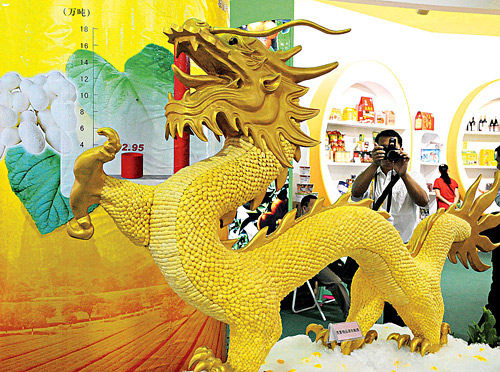|
 |
|
GOLDEN DRAGON: A visitor takes photos of a dragon statue built from 9,999 silkworm cocoons for the first agricultural exhibition at the China-ASEAN Expo on October 20 (MA PING) |
Exhibits mainly included consumer goods, redwood furniture, jewelry, clothes, decorations, palm oil and related products, coconuts, seafood, coffee, fruit beverages, dried fruit, fish paste, perfumed candles, amethyst, silver ornaments, pottery and porcelain.
Agricultural cooperation
Prior to the Expo's opening, China and ASEAN members inked the Nanning Consensus in a bid to step up agricultural exchanges to help improve regional development and prevent food crises that have already plagued some regions.
"Agriculture is a major field for strategic cooperation among China and the ASEAN members, which is an important part of the creation of the China-ASEAN FTA," said Qin Ruixiang, Vice Chairman of the Standing Committee of the Guangxi Zhuang Autonomous Regional People's Congress.
The parties identified seven areas as the priorities for exchange and cooperation, including agro-industry and food security, new crop varieties and animal breeds, agricultural sciences and technology, biomass energy, agricultural processing and logistics, animal husbandry and fisheries.
They also vowed to optimize the allocation of resources such as labor and funding, expand cooperation on technology and personnel training and intensify agricultural investment in ASEAN.
China and the ASEAN countries launched a program in 2004 that set as a goal scrapping tariffs on about 600 agricultural imports on both sides by 2006. The program was part of the FTA framework agreement signed by China and the ASEAN countries in 2002, according to Xu Ningning, Secretary General of the China-ASEAN Business Council Chinese Secretariat. He said the program had boosted agricultural production in the region and accelerated the trade of agricultural products.
Data from China's Ministry of Agriculture showed the country's agricultural exports to ASEAN hit $4.58 billion in 2008, up 16 percent from the previous year, and agricultural imports from ASEAN rose 30.2 percent year on year to $9.24 billion.
Financial cooperation
Another highlight of this year's Expo was the China-ASEAN Financial Cooperation and Development Leadership Forum, whose goal was "to deepen exchanges and cooperation, and to establish a China-ASEAN financial services platform."
A financial services exhibition with 125 booths was held as part of the forum. Insurance institutions, financial services organs and overseas financial institutions including Nanyang Commercial Bank, Development Bank of Singapore and Saigon Thuong Tin Commercial Bank also presented their offerings.
"There is huge potential for financial cooperation between China and ASEAN as the two sides record fast development in the financial sector, but their financial ties are inadequate to keep up with their trade exchanges," said Su Ning, Vice Governor of the People's Bank of China, the country's central bank. "There are also challenges ahead, and the Chinese central bank will step up talks with central banks of the ASEAN member states to develop a stable and flexible mechanism for financial cooperation."
China would gradually open the country's financial markets and develop a favorable environment for ASEAN financial institutions to set up branches in China or take stakes in Chinese financial institutions, he said.
Li Ruogu, Chairman of the Export-Import Bank of China, expected countries in the region to further open financial and capital markets, ease limits on market entry into their financial sectors, develop new financial products and push forward settlement cooperation to reduce dependence on the U.S. dollar.
In July of this year, China implemented a pilot scheme for cross-border renminbi trade settlement in Shanghai. Currently, China has signed cooperation agreements for bilateral trade settlements with the central banks of Laos and Viet Nam.
Heads of other commercial banks present at the forum, including the Bank of Communications and China Merchants Bank, also pledged more cooperation with their counterparts in ASEAN member states.
Phouphet Khamphounvong, Governor of the Bank of Laos, said the Laotian Government is aware of the benefits from opening financial markets and financial cooperation as his country's central bank has signed cooperation pacts with China's central bank and the China Development Bank. Laos will work to further cooperate regionally, he said.
The forum was held at a time when nations are pushing forward reforms for the world financial system after the financial crisis, which originated in the United States, dragged the global economy into recession.
Xiao Gang, Chairman of the Bank of China, said China and ASEAN should strengthen financial cooperation, which is an important force to weather the economic downturn and help stabilize the world economy.
The 1997 Asian financial crisis and the 2008 global financial crisis showed that no single economy could rein in the spread of crisis and instead nations must work together, he said. | 